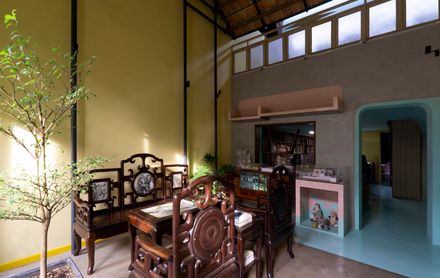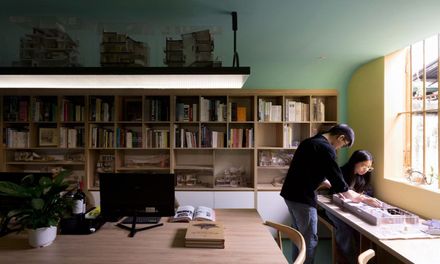ARCHITECTS
Ad+studio
PRINCIPAL ARCHITECTS
Nguyễn Đặng Anh Dũng
PHOTOGRAPHS
Ad+studio; Dung Huynh
AREA
96 M²
YEAR
2022
LOCATION
Vietnam
CATEGORY
Offices, Adaptive Reuse
The project is located in a small alley called Hao Sy Phuong in Cho Lon, built 100 years ago – when Chinese merchants set up loads of shophouses in Saigon.
Nowadays, when most of these shophouses are being disassembled and replaced since they are not classified as cultural property and cannot be utilized properly, the main structure of this neighborhood still needs to be managed. There are only a few changes in the room layout and decorations depending on the needs of each household.
In the general architectural composition, the two-storey buildings are oriented around a shared courtyard, catching wind and light and being a space for community interaction. Individually, each module of the two upper-lower houses shares a mutual atrium.
This is the ventilation route and the solution to the lack of light created by a typical shophouse’s long and narrow floor plan. Those two sharing qualities in both general composition and module structure illustrate the solidarity characteristic of the Chinese community. The renovation focuses on exploiting the value of those atriums – the cores.
The front, which connects directly with the courtyard, uses the traditional architectural language to harmonize with the old neighborhood’s context. A tile roof is added, using the old tiles from the original roofs. This second roof reduces heat radiation from above, stylizes the traditional house structure, and recreates the local architecture that has been lost when replacing the roof with new materials.
The space is used for visitor/client meetings, expressing the “respect the context” basis in the studio philosophy. The back is the design office, revolving around an internal atrium. The design emphasizes the old-new contrast in language and materials: removing decorative motifs, simplifying form, and blurring the boundaries between floor planes, ceiling, and walls, featuring the new-function space. The mezzanine is a co-working space and can be used for resting out of office hours, leaving 50% of the area for a VOID, a solution to the lack of light and reveals the original construction technique of the building.
This buffer space is also a dialogue between the new and the old, a solitude space for meditation and concentration. The building is renovated for residential purposes while being an architecture office, performing three main functions.
The front, making direct contact with the courtyard, stylizes the traditional architectural language to harmonize with the old neighborhood’s context. A tile roof is added, using the old tiles removed when the neighborhood replaced its entire tile roof system with a tin roof.
This second roof reduces heat radiation from above, stylizes the traditional house structure, and recreates the local architecture lost when replacing the roof with new materials.
This is the space for visitor/client meetings, expressing the “respect the context” basis in the studio philosophy. The back is the design office, revolving around an internal atrium.
The design emphasizes the old-new contrast in language and materials: removing decorative motifs, simplifying form, and blurring the boundaries between floor planes, ceiling, and walls, featuring the new-function space.
The mezzanine is the place for the principal architect to work and rest, leaving 50% of the area for a VOID, a solution to the lack of light and reveals the original construction technique of the building. This buffer space is a dialogue between the new and the old, a solitude space towards meditation and concentration for designing.
In the general architectural composition, the two-story buildings are oriented around a shared courtyard, catching wind and light and being a space for community interaction. Individually, each module of the two upper-lower houses shares a mutual atrium.
This is the ventilation route and the solution to the lack of light created by a typical shophouse’s long and narrow floor plan. Those two sharing qualities in both general composition and module structure illustrate the solidarity characteristic of the Chinese community.
To become an office, the lower floor partitions are removed. It also creates the ventilation route between the front common atrium and the rear private atrium.
The mezzanine is rearranged from two separate rooms into one workroom and a buffer zone. The new design also contains a material solution to catch light from the roof.
The buffer zone resembles the third atrium, following the general void concept of the context while being the solution for the lack of light & removing the room formerly blocking the wind, creating the convection for the mezzanine.
In the city gentrification, the Government decided to replace the old tile roofs with tin roofs and re-paint the whole façade of the building in this neighborhood.
Although this solved the immediate need for maintenance, it accidentally destroyed the richness of the one-hundred-year-old area when each building’s color & decoration showed the individual characteristics of each family.
The building retains all the replaced roof tiles and adds a new structural system from the reused materials when dismantling components of the existing building, creating a new shell for the front space.
This structural system simulates the traditional structure but omits the carving detail & changes the material from wood to iron, recreating the old atmosphere in a new & contemporary form.
Adding a truss system inside the building also solves the mutual wall disadvantage between two adjacent houses. The renovation has almost no impact on the two existing walls, which have been built for about 100 years.
To become an office, the lower floor partitions are removed. The design emphasizes the old-new contrast in language and materials: removing decorative motifs, simplifying form, and blurring the boundaries between floor planes, ceiling and walls, featuring the new-function space.
The building utilizes the natural ventilation and natural lighting from the atrium. The design aims for free floor plan, removes the room formerly blocking the wind, creates natural ventilations & lighting throughout the building.
Adding a new roof using the original tiles creates the second heat reduction layer, the void between the tin & the tiles roof becomes a convection, which helps to reduce the heat from the tin roofs to the spaces below.





















